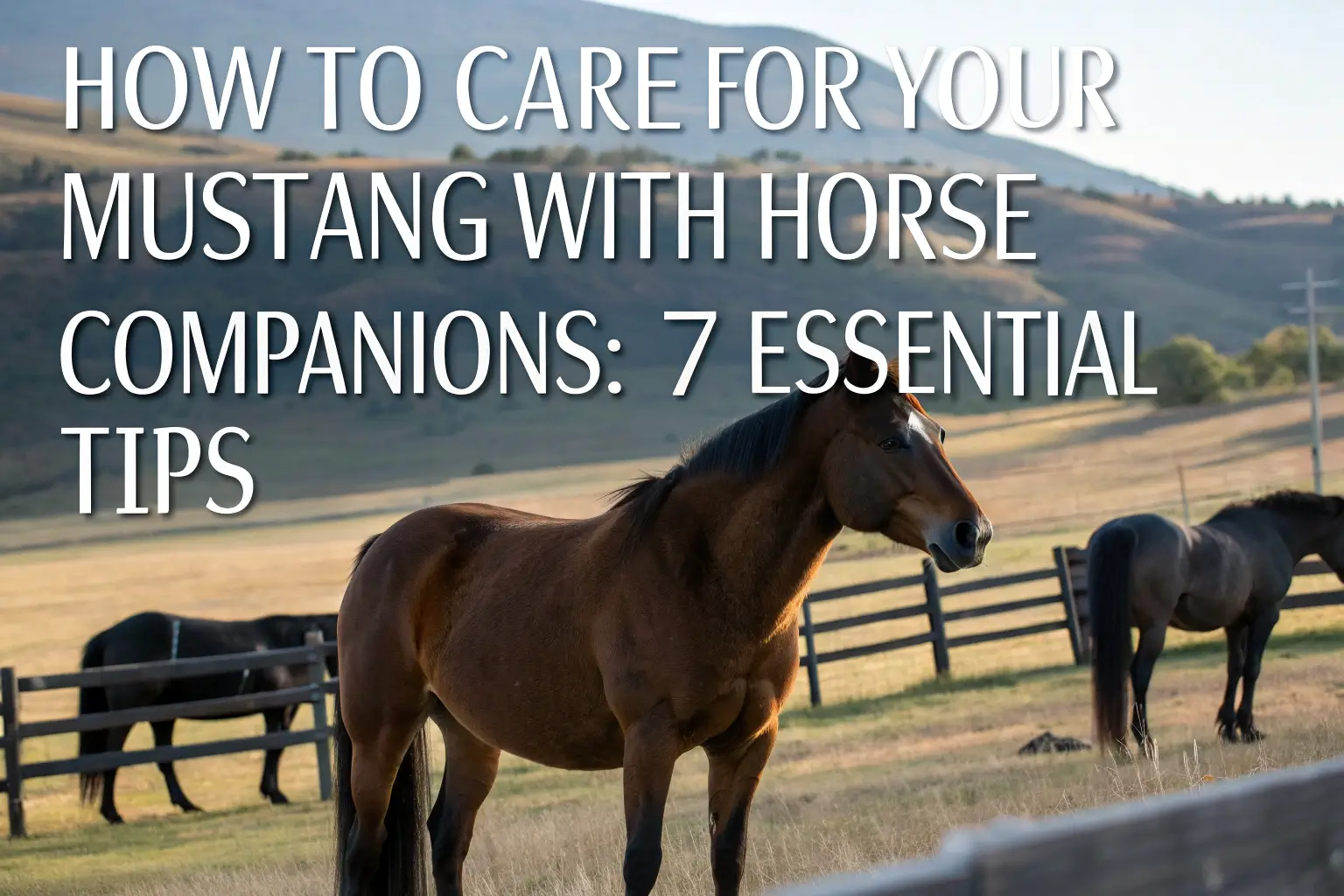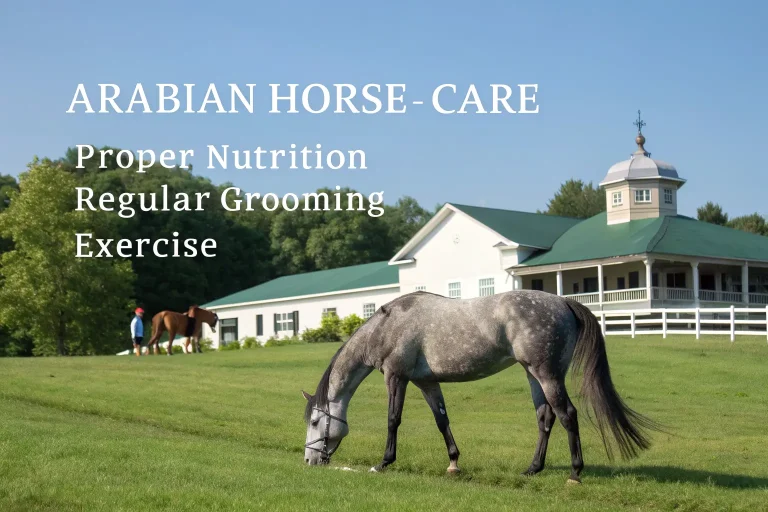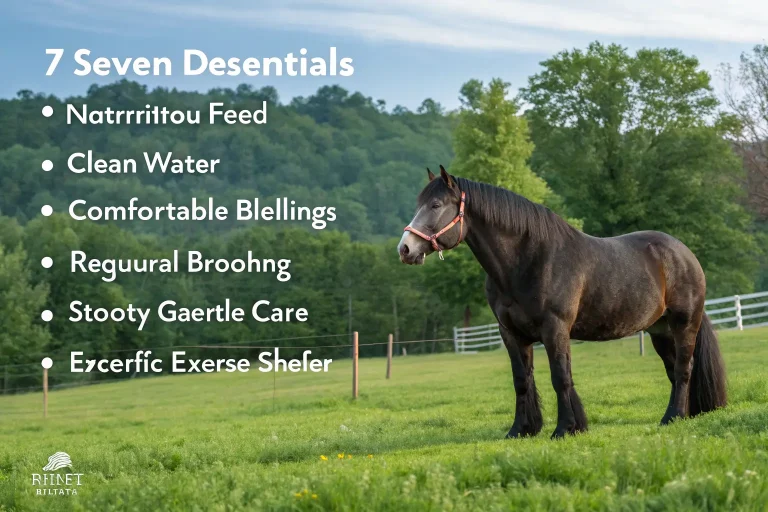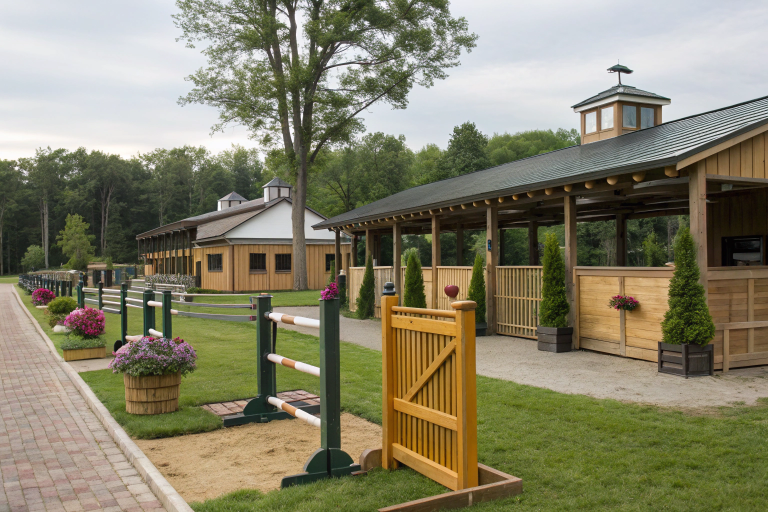How to Care for Your Mustang with Horse Companions: 7 Essential Tips
Are you struggling to manage your mustang with horse companions in a shared environment? Wild mustangs bring unique challenges when integrated with domestic horses, requiring specialized knowledge and patience. This comprehensive guide offers proven strategies to help your mustang thrive alongside other equines while preserving the natural behaviors that make these magnificent animals so special.
Introduction
The American mustang represents a living legacy of the American West—wild, resilient, and fiercely independent. When introducing a mustang to domestic horse companions, you’re merging two worlds: the untamed spirit of the wild with the domesticated nature of traditional equines. This delicate balance requires thoughtful management and understanding.
Mustangs are descendants of escaped domestic horses brought to America by Spanish explorers in the 16th century. After generations in the wild, they’ve developed unique traits and social behaviors that distinguish them from typical domestic horses. Interestingly, many mustangs can form incredibly strong bonds with both humans and other horses once trust is established—sometimes even stronger than those formed by horses born in captivity.
Whether you’ve adopted a Bureau of Land Management (BLM) mustang or acquired one through other means, learning to care for these special animals alongside other horses demands specific knowledge and techniques.
Understanding Mustangs: Background and Characteristics
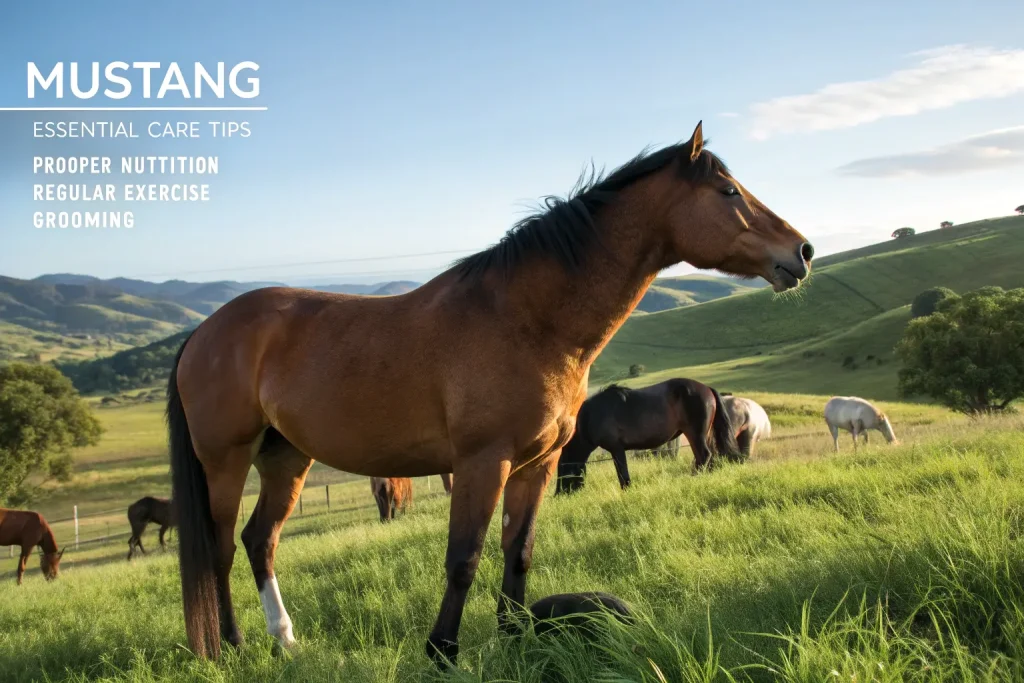
Scientific Name: Equus caballus (same as domestic horses)
Physical Characteristics: American mustangs typically stand between 13 and 15 hands high (52-60 inches), though this can vary. They possess compact, muscular bodies built for endurance rather than speed. Colors vary widely from bay, black, and chestnut to dun, roan, and pinto patterns. Many mustangs display primitive markings like dorsal stripes and leg barring—evidence of their ancient lineage.
Adaptations: Through generations of natural selection, mustangs have developed remarkable hardiness. Their hooves tend to be stronger than domestic horses, and they often display heightened situational awareness. Many have evolved to thrive on sparse vegetation and can maintain healthy weight on less feed than many domesticated breeds.
While not technically a distinct breed, mustangs are recognized for their exceptional endurance, intelligence, and surefootedness—traits that can complement a herd of domestic horses when properly managed.
Tip 1: Create a Proper Introduction Environment
The first interaction between your mustang and other horses will set the tone for their relationship. Unlike domestic horses that may have been regularly introduced to new herd members, mustangs come from environments where herd dynamics were established through natural processes.
Slow and Strategic Introductions:
- Begin with fence-line introductions, allowing horses to see and smell each other safely
- Choose a neutral territory when possible to prevent territorial aggression
- Pair your mustang first with a calm, confident horse with good social skills
- Avoid introducing multiple horses simultaneously, which can overwhelm a mustang
Karen McCall, an equine behaviorist specializing in wild horse integration, explains: “Mustangs read body language with extraordinary precision. A gradual introduction gives them time to process and adapt to new herd members without triggering their flight response.”
Successful integration might take days or even weeks—patience is essential for building the foundation of a stable relationship between your mustang and other horses.
Tip 2: Understand and Respect Herd Dynamics
Mustangs with horse companions rely heavily on established social structures to feel secure. In the wild, mustang herds have clear hierarchies that create order and safety.
Natural Hierarchy Development:
- Allow horses to establish their own pecking order with minimal interference
- Watch for normal dominance displays versus dangerous aggression
- Ensure each horse has adequate space to move away during initial interactions
- Recognize that your mustang may initially hold a lower position before finding their place
Research published in the Journal of Equine Behavior shows that wild horses typically establish dominance through subtle cues rather than outright aggression. Your mustang may display behaviors like ear pinning, neck arching, and strategic positioning before physical interactions occur.
“A mustang’s position in the herd may shift several times during the first few months,” notes Dr. Emily Weiss, animal behaviorist. “This fluidity is normal and allows the group to find its most functional dynamic.”
Be prepared for your mustang with horse companions to go through an adjustment period as they learn the social cues and expectations of domestic horses, which may differ from wild herd behaviors.
Tip 3: Design Appropriate Feeding Strategies
Feeding time can create tension in any herd, but particularly when mustangs are involved. Having evolved to forage continuously on sparse vegetation, mustangs may approach feed resources differently than domestic horses.
Effective Feeding Approaches:
- Provide multiple feeding stations spaced well apart (at least 20-30 feet)
- Consider using slow feeders to mimic natural grazing patterns
- Feed higher-ranking horses first or separately if needed
- Monitor body condition scores carefully as mustangs may require less feed
“Mustangs evolved to maintain healthy weight on marginal nutrition,” explains equine nutritionist Dr. Juliet Getty. “Many owners unknowingly overload their mustangs with rich feeds designed for performance horses, leading to metabolic issues.”
A study from Colorado State University found that mustangs typically maintain better metabolic health when allowed to follow natural feeding patterns rather than scheduled, concentrated meals. Consider implementing a track system or other management approach that encourages movement while eating.
Tip 4: Provide Adequate Space and Shelter
Mustangs with horse companions require appropriate physical environments to thrive. Coming from vast open ranges, mustangs often struggle with confinement more acutely than domestic horses.
Space Requirements:
- Minimum 2-3 acres for a small herd (3-4 horses) when possible
- Multiple entry/exit points from shelters and pasture areas
- Visual barriers like trees, rolling terrain, or run-in sheds that create “escape spaces”
- Secure fencing at least 5-6 feet tall with no sharp edges
Sarah Ralston, VMD, PhD, recommends: “Create environments where your mustang can make choices—where to eat, rest, or seek shelter. This sense of autonomy reduces stress and promotes better integration with domestic horses.”
Mustangs often prefer open shelters rather than enclosed stalls, as they value the ability to see potential threats. When designing your facility, consider how to balance protection from the elements with a mustang’s need for visibility and escape routes.
Tip 5: Develop Trust Through Proper Training Approaches
Training a mustang requires techniques that may differ from those used with domestic horses. Additionally, how you handle your mustang affects their relationships with other horses.
Effective Training Methods:
- Use pressure-and-release techniques rather than force
- Incorporate liberty work to build communication skills
- Respect the mustang’s personal space while gradually reducing flight distance
- Practice patience—mustangs may take longer to trust but often form stronger bonds
“The best approach for mustangs combines clear boundaries with consistent fairness,” explains Mustang Heritage Foundation trainer Anna Twinney. “When your mustang trusts your leadership, they’ll be more confident in the herd setting.”
Consider beginning with groundwork fundamentals before riding. Research by equine cognition specialist Dr. Evelyn Hanggi demonstrates that horses trained through positive reinforcement and clear communication show lower stress levels and better social adjustment than those trained through dominance-based methods.
Tip 6: Address Health Considerations Unique to Mustangs
Mustangs with horse companions may have different health needs than domestic horses, requiring adaptations to your regular equine healthcare routine.
Health Management Approaches:
- Schedule gradual introduction to vaccines and dewormers
- Consider testing for mineral imbalances common in mustangs from certain regions
- Implement careful dental care, as many mustangs have never had dental work
- Find a veterinarian experienced with mustangs or wild horses
“Mustangs often have more robust immune systems but may react differently to standard medications,” notes equine veterinarian Dr. Robert Miller. “Always inform your vet about your horse’s mustang background before treatments.”
Be particularly vigilant about hoof care. While mustangs naturally develop strong hooves, the transition to domestic environments often requires proper trimming to prevent imbalances. Consider a barefoot approach when appropriate, which often suits mustangs better than traditional shoeing.
Tip 7: Provide Mental Stimulation and Enrichment
Boredom can lead to behavioral problems in any horse, but mustangs with horse companions may be particularly susceptible given their background of constant movement and environmental challenges.
Enrichment Strategies:
- Create variation in the environment with terrain changes, obstacles, and exploration opportunities
- Utilize puzzle feeders and forage opportunities throughout the day
- Introduce natural challenges like logs, water crossings, and varied surfaces
- Consider incorporating other species like goats or donkeys that create a more natural ecosystem
Research from the University of Pennsylvania’s School of Veterinary Medicine suggests that environmental enrichment significantly reduces stress behaviors in previously wild horses. Dr. Sue McDonnell observes: “Horses evolved to move 10-20 miles daily while making constant decisions about food and safety. Creating environments that stimulate these natural behaviors improves both mental and physical health.”
Many successful mustang owners implement track systems, which create movement-based living environments that encourage natural behaviors while maintaining the advantages of domestic care.
Conservation Status of American Mustangs
Current Population: Approximately 86,000 wild horses roam public lands managed by the Bureau of Land Management, with additional populations on tribal lands and other territories.
Threats: Mustangs face challenges including habitat loss, competition for resources with livestock, controversies over appropriate population management, and climate change affecting water sources.
Protection Status: American mustangs are protected under the Wild Free-Roaming Horses and Burros Act of 1971, though debates continue about implementation and management approaches.
Understanding the conservation context helps owners appreciate the cultural and historical significance of integrating these living symbols of American heritage with domestic horses.
Interesting Facts About Mustang Behavior
- Mustangs can recognize individual horses (and humans) they haven’t seen for years
- Wild mustang herds typically travel in a specific order, with experienced mares leading and stallions bringing up the rear
- Mustangs often develop specialized skills like finding water in arid environments or predicting weather changes
- Studies show mustangs typically have more complex social relationships than established domestic horse herds
These natural behaviors may manifest when your mustang interacts with other horses, sometimes in surprising ways that enrich the entire herd dynamic.
The Role of Mustangs in Healthy Herd Environments
When properly integrated, mustangs can positively influence domestic horse herds through:
- Teaching natural vigilance and awareness
- Demonstrating effective communication skills
- Modeling proper movement patterns
- Encouraging more natural social structures
“Many of our clients report that after introducing a well-adjusted mustang, their entire herd becomes more cohesive and naturally behaved,” reports Mark Rashid, horse trainer and author. “There seems to be a ‘grounding’ effect that these horses bring from their wild heritage.”
This influence can be particularly valuable for horses that have spent most of their lives in stalls or isolated environments, as mustangs model healthier social and movement patterns.
Conclusion
Successfully caring for a mustang with horse companions requires patience, knowledge, and adaptability. Through proper introduction techniques, respect for natural behaviors, and thoughtful management practices, you can create an environment where both your mustang and domestic horses thrive together.
The journey of integrating a mustang into your equine family offers unique rewards—witnessing the transformation as these resilient animals connect with their domestic counterparts while maintaining the spirit that makes them special. By implementing these seven essential tips, you’ll be well on your way to fostering a harmonious and enriching environment for your entire herd.
Whether you’re a new mustang owner or looking to improve your current management approach, remember that each mustang is an individual with unique experiences and needs. The time invested in understanding and accommodating these needs pays dividends in the remarkable relationships that develop between mustangs, their human caretakers, and their horse companions.
Frequently Asked Questions
How long does it typically take for a mustang to integrate with domestic horses?
Integration timelines vary greatly depending on the individual mustang’s background and the existing herd dynamics. Some mustangs may integrate within weeks, while others take 6-12 months to fully adjust. Patience and careful observation are essential during this process.
Do mustangs require different nutrition than domestic horses?
Yes, many mustangs evolved to thrive on sparse vegetation and may develop metabolic issues on rich feeds. They typically require fewer calories and less concentrated nutrition than many domestic horse breeds. Work with an equine nutritionist familiar with mustangs to develop an appropriate feeding program.
Can mustangs live in stalls or do they need constant turnout?
While individual preferences vary, most mustangs strongly prefer access to open spaces. Many struggle with stall confinement, displaying stress behaviors when confined. At minimum, provide large stalls with visibility to other horses and significant daily turnout when stalling is necessary.
Will my mustang teach my domestic horses “bad behaviors”?
Rather than “bad behaviors,” mustangs typically display natural horse behaviors that may have been suppressed in domestic environments. With proper integration and training, these natural behaviors usually enhance the overall herd dynamic rather than creating problems.
How do I find a trainer experienced with mustangs?
Look for trainers affiliated with organizations like the Mustang Heritage Foundation, contact successful BLM adoption mentors, or consult with rescue organizations specializing in mustangs. The right trainer will emphasize trust-building and respect for the mustang’s unique psychology rather than applying one-size-fits-all training methods.
Do mustangs bond more strongly with other mustangs than with domestic horses?
While mustangs may initially gravitate toward other mustangs, they can form equally strong bonds with domestic horses over time. The quality of relationships depends more on individual personalities, compatible energy levels, and proper introduction techniques than on whether horses share a mustang background.
How can I tell if my mustang is happy in their new herd environment?
Happy, well-adjusted mustangs display relaxed body language, willingly interact with other horses, maintain healthy weight, and show curiosity about their environment. Watch for natural behaviors like mutual grooming with herdmates, playful interactions, and comfortable rest patterns as signs of successful integration.

